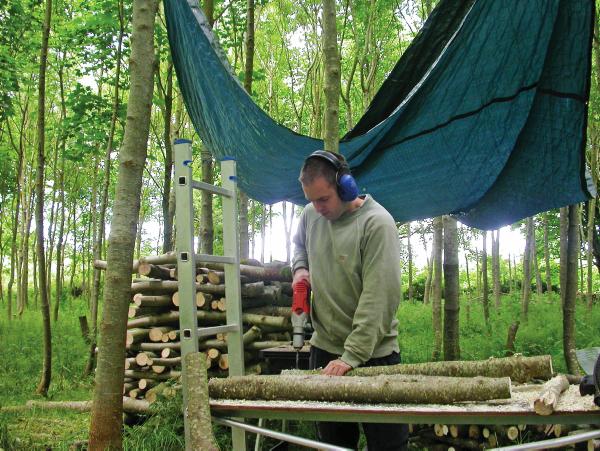Chalara is a major threat to ash while P. Ramorum — known as sudden oak death — has been detected in a number of larch forests.
While most plant diseases are caused by fungi, they also play a beneficial role in forest ecosystems (see panel). In addition, edible fungi production has long been recognised as a non-wood revenue generator in European forestry. This was discussed at a recent seminar organised by Teagasc and the Society of Irish Foresters in association with the Society of Irish Pathologists.
Gathering mushrooms goes back thousands of years in the Orient and has a centuries-old tradition in Europe. According to Paul Dowding and Louis Smith in Forest Fungi in Ireland, the sale of wild mushrooms was so popular in Europe that health and safety measures were introduced to prevent unscrupulous traders from passing on dangerous mushrooms.
However, Ireland has had a very conservative approach to mushroom growing and collection, apart from field mushrooms. Mushroom gathering in the forests of Europe, like other non-wood aspects of forestry such as berry collection, is a commercial and recreational activity but is missing in Ireland. This is probably due to a number of factors including our low forest cover, conservative approach to food and a deep suspicion that most mushrooms are poisonous.
However, attitudes may be about to change, thanks to a project carried out in three farm forests in Co Limerick. Part funded by COFORD in the Department of Agriculture, Food and the Marine, the project is examining the production potential of edible fungi.
Dr Tom Harrington, University of Limerick (UL), provided some early results of the project carried out alongside forest owner John O’Connell and Marie Cullen, Department of Life Sciences, UL.
While the main aim of forest management is to produce a timber crop, the project is examining three edible fungi that could supplement income from the forest — the mushrooms oyster and shiitake and the underground truffle, regarded as the crème de la crème of edible fungi.
Unlike, traditional mushroom picking sites in the continent, which have centuries of unbroken woodland cover, the Limerick project is located in plantation forest. Field trials were established in 2008 after first thinnings were carried out. These included the production of oyster mushrooms (Pleurotus ostreatus) and shiitake ((Lentinula edodes) by inoculating stumps and logs cut after thinning.
Logs and stumps of ash, beech, oak and sycamore were inoculated with mushroom mycelia. Among the objectives were to assess the performance of the two species of fungal growth and to determine the influence of stump size and type, log type and size, and moisture content on mushroom yield.
They also established a truffle orchard trial to determine whether a plantation of Tuber aestivum inoculated host trees will yield commercially viable quantities of truffles.
This project has a longer trial period as pre-inoculated trees are planted in the truffle orchard.
The inoculation of stumps and logs provided shorter-term results than truffle production. Dr Harrington said that the preliminary results were positive in some species. “For example, shiitake cultivation on beech or oak logs yielded good quality, marketable quantities,” he said. “Stump cultivation of oyster mushrooms also offers some potential within a farm forest scenario.”
Beech and ash stumps produced relatively little fungi, while oyster fruitbodies began early on sycamore. Shiitake mushrooms were more productive than oyster and significantly greater than oyster on beech and sycamore logs.
Irrigation is an important aspect of fungi production with best results achieved on logs with moisture content over 35%. The preliminary results are positive but the work is labour intensive and the economics of producing edible fungi in a forest have yet to be evaluated.
John O’Connell, owner of the RDS award winning forest in Blossom Hill where one of the projects is located is happy with progress to date. “We are already producing sufficient quantities of mainly shiitake mushrooms for two gourmet restaurants and we hope to increase supply,” he said.
WHAT ARE FUNGI?
Fungi, as distinct from green plants, reproduce by spores and include mushrooms, yeasts, moulds, rusts and mildews.
Most fungi consist of a network of slender tubes called hyphae that require organic matter, moisture and oxygen to spread.
Fungi absorb food and break down complex substances into molecules that can be absorbed into the hyphae. In that sense, they are waste disposers, which is obvious in a forest where they break down and recycle organic matter such as dead trees.
It is estimated that over 100,000 species of fungi exist and while they can be extremely destructive, they are also beneficial, especially mycorrhizae (from the Greek ‘fungus-root’).
Mycorrhizae are the result of symbiosis, or close association, between specific soil fungi and the roots of plants. Fungi absorb food such as sugars from the plant and the plant receives water and dissolved nutrients from the fungus.
The plants and fungi become inextricably linked with benefits for both to such a degree that many believe that plant root and fungi may be dependent for survival.
Most tree species benefit from this symbiosis, including our most popular conifers spruce, pine, larch and firs along with the broadleaves oak, beech and birch.






SHARING OPTIONS